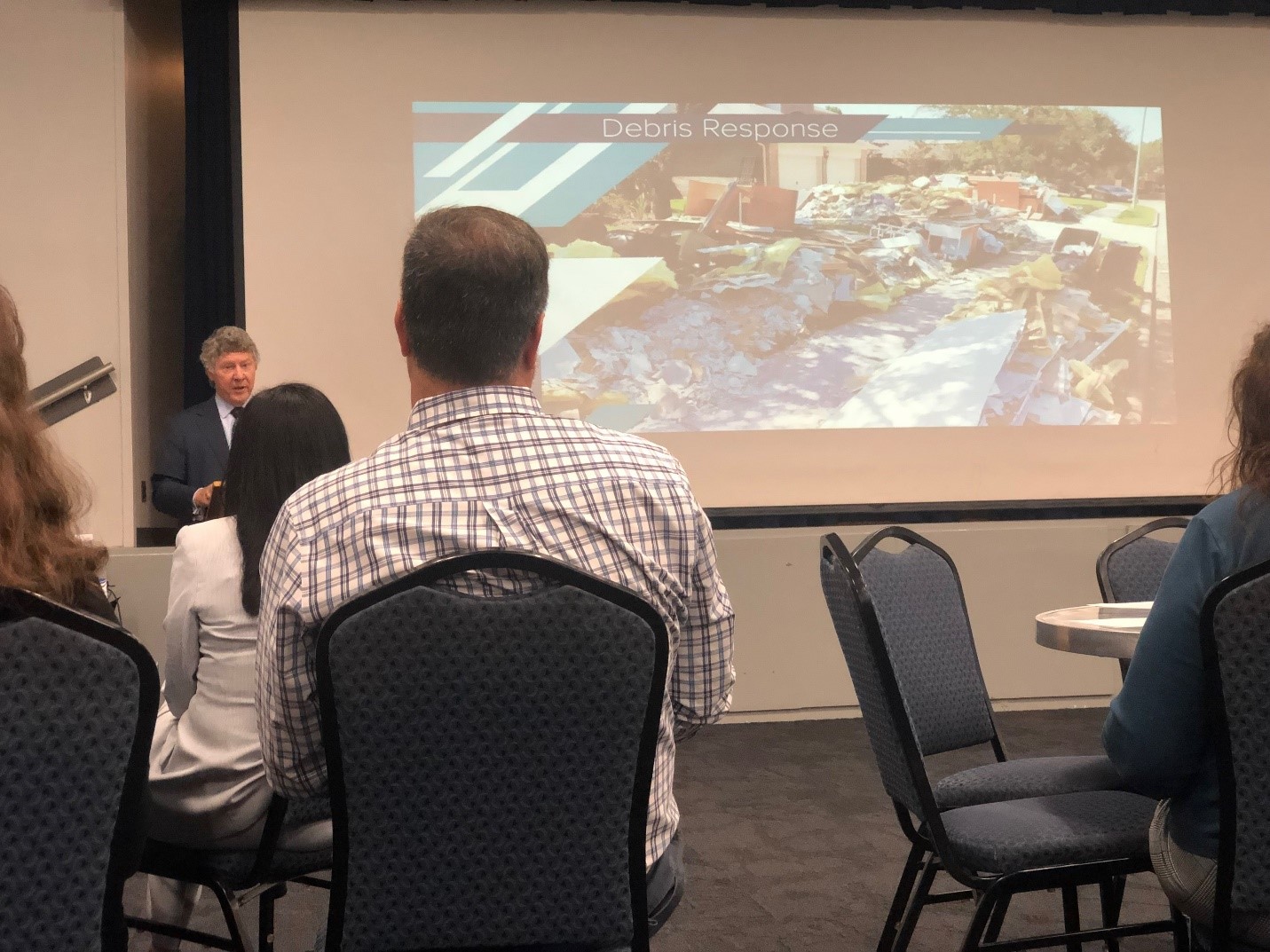A Timely Reminder That Hurricanes are Bad News; Ditto for Excessive Rain
“We had wildfires, chemical spills, the Tax Day flood and the Memorial Day flood. But nothing prepared us for Harvey.” – Judge Ed Emmett
Harris County Judge Ed Emmet joined NASA Johnson Space Center’s Contractor Safety and Health Forum to offer insight into hurricane and emergency preparedness. He shared his experience with handling Harvey and other emergencies as the Harris County director of Homeland Security and Emergency Management.
“People know me as the guy who said ‘hunker down’ on live television,” Emmett siad. “I know it’s going to be on my tombstone: Ed Emmett, hunkered down forever.” His quick wit and dry humor engaged the crowd before he dove into the serious details of emergency management.
On Aug. 25, 2017, Harvey became a Category 4 hurricane before making landfall along the Texas coast. More than 60 inches of rain pummeled southeast Texas, causing $125 billion in damages. Sixty-eight people lost their lives.
“Hurricane Harvey wasn’t a hurricane in Harris County,” Emmett said. “It was a rainstorm, which made it much more difficult to plan for.”

The International Space Station orbited over Hurricane Harvey, and the crew photographed the storm bearing down on the Texas Coast. Image Credit: NASA
Emergency operations requires exceptional organization and strategies. “You can’t do it just when the emergency occurs. You have to plan in advance,” Emmett said. “You have to know who you’re dealing with and have partnerships established and maintained.”
Agencies, companies and people need their own emergency systems to mitigate risk. One of the half-dozen anecdotes Emmett regaled hit this point.
Harris County has 250-300 potential shelter sites that the Emergency Operations Center can activate at any time. Emmett mobilized 36 sites during Harvey, but discovered that the Red Cross (responsible for supplying the shelters) didn’t have any drivers. Trapped in their homes like everyone else, the Red Cross volunteer drivers couldn’t make it in to help. “This can be a problem when having to rely on volunteers,” Emmett noted.
Scrambling to find new drivers at a moment’s notice, Emmett contacted METRO. Since the department wasn’t running, they offered some volunteers. Emmett went back to the Red Cross and said, “I got your drivers. What’s next?”
The Red Cross representative awkwardly said they didn’t have any trucks. “If someone makes the wrong decision, the time to argue about it is not during the event,” Emmett said. “In the middle of the storm, you have to stick together and keep focused.”
The Red Cross had moved their trucks several days before to avoid flooding. Finding replacement trucks became the next urgent task. Emmett connected with UPS, Mattress Mack and other companies, which generously donated the use of their trucks. Luckily, the Red Cross had supplies, and they were able to finally open the 36 shelters.
“None of that was part of our plan. You have to be flexible. You have to make things work,” Emmett said.
As the storm wreaked havoc through Houston, the George R. Brown Convention Center brimmed with evacuees. Opening the NRG Stadium as a shelter for 10,000 people now fell on Emmett.
“According to the plan, FEMA and the Red Cross were supposed to do that. FEMA had trucks and supplies, but they couldn’t get here because of flooding,” Emmett said. He reached out to Angela Blanchard, president of BakerRipley (formerly Neighborhood Centers, Inc.)—the largest community-development organization in Texas. Emmett asked her group to help with assembling NRG. Angela agreed and estimated a 12-hour turnaround. “They got it set up in 11.”
NRG is now used as the model shelter across the world, and it all changed because of one thing Blanchard insisted on. “I’ll set it up under one condition,” she said. “You don’t have any evacuees—you will only have guests.”
This concept and mindset changed the entire tone of what a shelter operation was. “Responses to emergencies occur months, even years before, getting to know people and finding the right resources. Then, being able to call on those resources makes it all possible …” said Emmett. “I wouldn’t have been able to get NRG open if I didn’t happen to know Angela and Neighborhood Centers.”

Judge Ed Emmett presents about public safety and the decisions made during emergencies like Hurricane Harvey at Johnson’s Contractor Safety and Health Forum. Image Credit: Christie Reiser
“Any emergency operation needs to ensure everyone has the same information and that they’re talking to each other,” Emmett said. “It doesn’t mean you can’t make the wrong decision. You can. But at least everyone will be on the same page.”
Emmett showed his formula for resilience on the next slide:
(2P + 2R)(PPR) = RESILIENCE
-or-
(Prevention & Preparation + Response & Recovery) * (Policies, Priorities, Resources) = Resilience
Destruction can happen to anyone during a natural disaster. Consider your plan this hurricane season. Johnson’s Safety and Mission Assurance hurricane football offers extensive information on preparedness, checklists, evacuation and resources. Also, be sure to update your superivsor with your hurricane plan.







